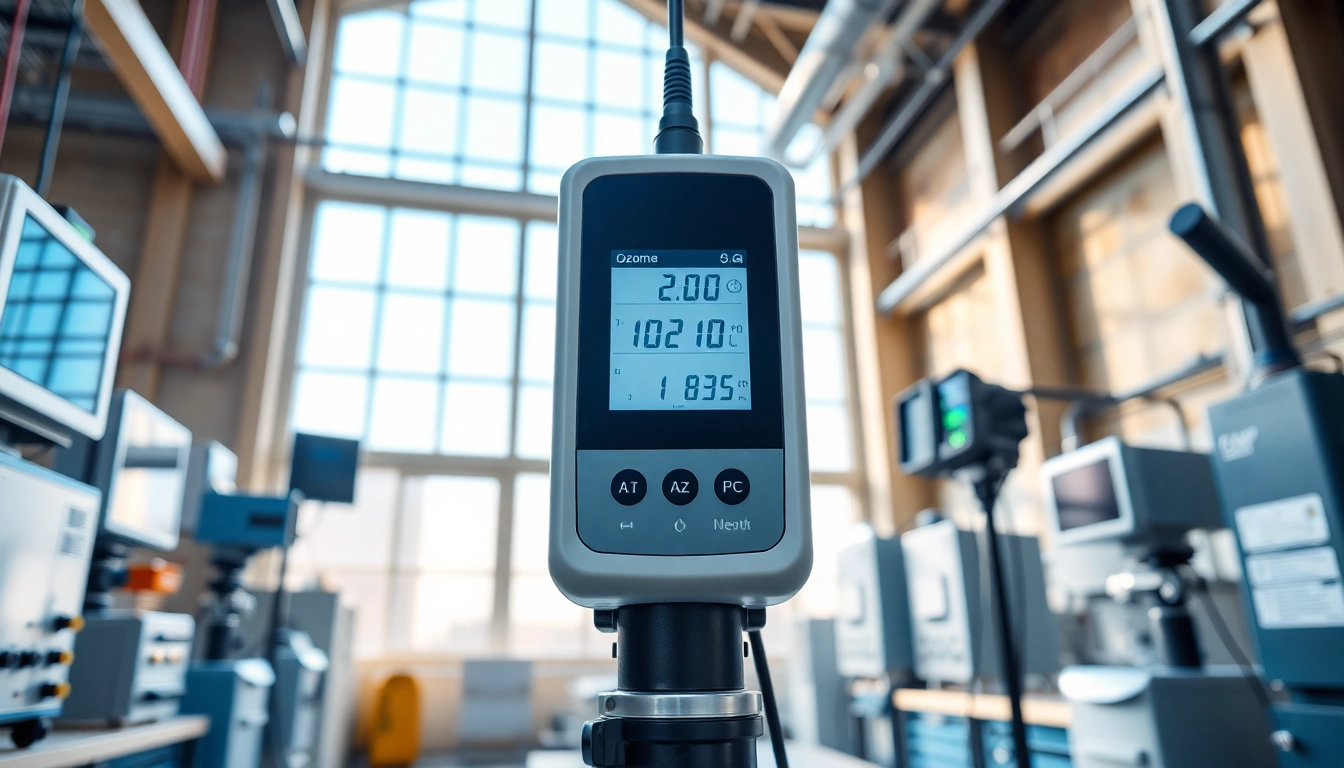Understanding Ozone Detectors
What is an Ozone Detector?
An ozone detector is a sophisticated instrument designed to measure the concentration of ozone (O3) in the atmosphere. This chemical compound, while essential in the upper atmosphere for shielding the Earth from harmful ultraviolet radiation, can be detrimental to human health and the environment when found at ground level. Ozone detectors serve various applications from industrial monitoring to ensuring safety in residential areas. They are essential tools for environmental compliance, contributing significantly to air quality management. For those involved in measuring air quality and ensuring safety in industrial environments, understanding how to utilize tools like an ozone detector is critical.
How Ozone Detectors Work
Ozone detectors operate on several technological principles, primarily through electrochemical, photometric, or semiconductor sensors. Electrochemical sensors involve a chemical reaction that generates an electrical current proportional to the ozone concentration. In contrast, photometric sensors utilize light absorption characteristics of ozone, measuring variations in light intensity to quantify ozone levels. Semiconductor sensors measure changes in conductivity relative to changes in ozone levels. These detection methods provide real-time data, enabling users to promptly respond to air quality issues.
Key Features of Ozone Detectors
Modern ozone detectors come equipped with various features that enhance their functionality and reliability:
- Real-time Monitoring: Continuous readings allow for immediate recognition of ozone level changes.
- Data Logging: The ability to record data over extended periods supports trend analysis and regulatory compliance.
- Alarm Systems: Integrated alarm functionalities alert users when ozone levels exceed safety thresholds.
- Calibration Alerts: Features that notify users when recalibrating is necessary ensure measurement accuracy.
- Portability: Many models are lightweight and battery-operated, allowing them to be used in various locations.
Importance of Ozone Detection
Health Effects of Ozone Exposure
Ozone exposure poses significant health risks, particularly affecting respiratory systems. Short-term exposure to elevated ozone levels can lead to symptoms like coughing, throat irritation, and chest pain. More alarming is its potential to trigger asthma attacks and reduce lung function, particularly in sensitive groups such as children, the elderly, and those with pre-existing respiratory conditions. Long-term exposure has been linked to more severe health issues, including chronic respiratory diseases and increased mortality rates. Thus, timely detection of ozone can significantly mitigate these health risks.
Environmental Impact of Ozone
Ozone at ground level contributes to environmental degradation, harming crops, forests, and wildlife. It affects plant health primarily by reducing photosynthesis and causing visible leaf injury, which can lead to diminished agricultural yields. Ozone pollution also exacerbates climate change by contributing to the formation of secondary pollutants, which are problematic for both ecosystems and human health.
Regulatory Standards for Ozone Levels
Various organizations, including the Environmental Protection Agency (EPA) in the United States, have established standards for allowable ozone levels in the atmosphere. The National Ambient Air Quality Standards (NAAQS) outlines these thresholds, which dictate compliance measures necessary to protect public health and the environment. Understanding these standards is crucial for industries and organizations in safeguarding compliance and ensuring community health.
Types of Ozone Detectors
Portable vs. Fixed Ozone Detectors
Ozone detectors can be classified into two primary categories: portable and fixed detectors. Portable ozone detectors are often compact and battery-operated, allowing for mobility and use in various environments, such as industrial sites or urban areas for air quality monitoring. In contrast, fixed ozone detectors are installed in a specific location for continual monitoring, typically integrated into building HVAC systems or in industrial applications to monitor prolonged exposure to ozone.
Comparing Different Ozone Detection Technologies
When selecting an ozone detector, it is essential to consider the various technologies available. Electrochemical sensors are known for their accuracy and ability to detect low ozone concentrations, making them suitable for sensitive environments. Photometric sensors, while generally providing higher sensitivity, can be more expensive and complex. Semiconductor sensors are versatile and compact but may require more frequent calibration. Each technology has its advantages, and choosing the right one depends on specific needs, including the required sensitivity, cost, and environment of use.
Choosing the Right Ozone Detector for Your Needs
Selecting the appropriate ozone detector involves assessing various factors: environmental conditions, required detection range, regulatory compliance needs, and the specific application of use. Conducting an assessment of potential areas of ozone exposure can significantly aid in identifying requirements. Additionally, considering user interface features, maintenance needs, and calibration frequency can streamline the choice process, ensuring effectiveness and reliability in ozone monitoring.
Best Practices for Using Ozone Detectors
Installation Tips for Accurate Readings
Correct installation is key to effective monitoring. When installing a fixed ozone detector, select a location that is representative of the area being monitored, avoiding obstacles that could obstruct airflow. For portable detectors, ensure they are at the correct height and are not placed in direct sunlight or near sources of interference. Regular checks and adjustments can help maintain accurate readings.
Routine Calibration and Maintenance
To guarantee sustained accuracy, regular calibration of ozone detectors is necessary. Most manufacturers recommend calibration at least once a year or more frequently in environments with high levels of ozone or variable conditions. Establishing a routine maintenance schedule, including sensor checks and battery replacements, can also ensure long-term reliability and effectiveness of the monitoring system.
Data Interpretation and Response Strategies
Understanding the data output from ozone detectors is crucial. Users should familiarize themselves with the normal range of ozone levels in their specific environment and develop response strategies when values exceed safety thresholds. Training staff on interpreting data signals and following prescribed response protocols can significantly enhance safety measures in workplaces or public areas.
Future Trends in Ozone Detection
Technology Advancements in Ozone Detection
The future of ozone detection looks promising with continuous technological advancements. Emerging technologies, such as low-power sensors and wireless communication, provide options for real-time data transmission and cloud-based analytics, increasing accessibility and ease of monitoring. These innovations not only enhance detection capabilities but also streamline data management, facilitating faster responses to air quality concerns.
Integration with Smart Home Devices
As smart home technology advances, integrating ozone detectors with IoT (Internet of Things) devices will become more common. This integration allows for automated monitoring and control of air quality, enabling users to receive alerts about ozone levels on mobile devices. Such capabilities align with growing consumer demand for smart and responsive solutions in managing indoor air quality.
Growing Applications in Various Industries
Ozone detectors are finding increasing application across a variety of industries, including healthcare, agriculture, and environmental services. In healthcare settings, they monitor air quality in facilities to ensure safe environments for patients. In agriculture, they help safeguard crops from ozone damage, and in environmental services, they enable compliance with regulations and ensure community safety. The identification of new applications will continue to expand the relevance of ozone detectors, making them essential tools in air quality management.



